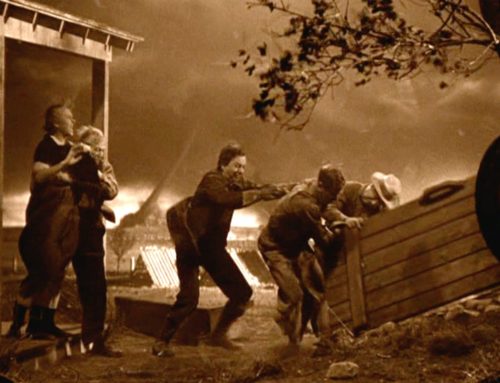This is a first-person, true account of the time my home was invaded and my mother was threatened with assault and murder. It includes many of the well-known elements of a home invasion. And it offers lessons for others out there who may not be aware of how quickly or easily our imagined fortresses can (and are) successfully invaded.
It was a typical winter evening in Iowa. Dark had come early, snow blanketed the ground outside. My mother and I, sharing the upstairs apartment located above my paternal grandparent’s home, were preparing for bed. Below us slept my grandparents and siblings.
Months earlier, my father had abandoned us. With nowhere else to go, we landed in the home of my grandparents. But even under such circumstances and in my father’s absence, we did not feel at risk – certainly not in a suburban Iowa winter.
After all, home is where we are supposed to feel safest. It’s our nest, our castle, our sanctuary from the craziness of the outside world. Yes, bad things happen, but they happen ‘out there.’
Which is precisely why home invasions take so many by surprise, are such a shock to the system. Suddenly faced with an arbitrary yet highly aggressive threat in our own homes, the old brain – the amygdala – kicks in. We fight, we flee, we freeze. And because so few of us have ever faced such events, the latter two impulses are often strongest.
The Home Invasion
First came the sound of breaking glass in the outside hallway leading up to our second-floor apartment. Someone or something had broken the door’s glass.
By the time my mother and I reached the door at the top of the steps, the intruder was already there. Violently twisting the knob with one hand, he battered at the door with his other. Our hearts, already startled by the sound of breaking glass, switched to full panic mode.
“Let me in, you bitch!” came the voice on the other side, followed by repeated shoulders to the door. Likely as ancient as the house itself, the door gave every indication it was about to break into pieces under the assault.
Together, my mother and I pushed our bodies against the door, hoping our combined weight was enough to keep out the deranged intruder.
There are more than one million home invasions in the U.S. each year.
Seemingly furious that we were fighting back, our home invader grew angrier, his language more foul and violent. Curiously, he seemed to have it in for my mother (home invaders often are familiar with the occupants of a home). “I’ll kill you, you [expletive] whore!”
A protective instinct snapped inside my mother. She turned and grabbed me by my skinny 12-year-old shoulders: “Go hide – NOW!”
I briefly hesitated, then ran into a bedroom and crawled behind its bed. Even there, I could hear the intruder’s shouts, could feel the walls shake under his assault on the door. Embarrassed by my cowardice, I returned to the door and joined my mother in attempting to keep him out.
With no other options at her disposal, my mother briefly left the door to stomp on the floor vent and shout below for my grandmother (my grandfather, though a big man, was seriously deaf). For the next minutes my mother alternated between the door and shouting through the vent.
I had never heard my mother scream like that before, never seen her so filled with fear. I pressed as hard as I could at the door, determined that he would not get to my mother (he seemed utterly unaware of my presence).
Crisis Averted
There is a line in Gordon Lightfoot’s hit song, The Wreck of the Edmund Fitzgerald, that perfectly describes the way time slows to a crawl when we find ourselves trapped in terror. “Does anyone know where the love of God goes, when the waves turn the minutes to hours?” In the case of the Fitzgerald, a monstrous Lake Superior storm was preparing to swallow whole the massive ship and its crew. My mother and I would be more fortunate.
I have no idea how long we fought to keep out the unseen intruder. I know my mother returned to the floor vent several times to shout for my grandparents, know too that the invader on the other side made countless threats against her.
38% of violent assaults and 60% of rapes occur during home invasions.
But at some point, the hammering at the door simply stopped, the threats with them. There was no sound at all aside from the heavy breathing coming from me and my mother.
Eventually, a different voice reached up to us from the outside – that of my grandfather. We tentatively opened the door and made our way down the staircase, past the broken glass and out onto the nighttime sidewalk where stood my grandparents, overcoats over pajamas, confused expressions in their sleepy eyes.
A pair of snowy footprints clearly illustrated someone had come across the yard, broken through the door, then departed in the same direction. And then, as we stood there huddled against the cold trying to explain what happened, a figure emerged from the darkness. “Hey, what’s going on?” he slurred.
Lessons Learned
Clearly drunk or strung out on drugs, the young man – perhaps in his late teens – had simply materialized at our side. My older sister, who had also appeared, immediately recognized him, cursed him and walked away, convinced he was the culprit. He sputtered some kind of incomprehensible defense, then disappeared back into the night, leaving the rest standing there in the cold.
This, as I would come to learn much later in life, is how such events so often unfold. A young male (almost always male), often under the influence and with a perceived score to settle, breaks into a home. Once inside, emotions skyrocket, bad things ensue.
Mercifully for us all, the night ended with little more than some broken glass and badly frayed nerves. But in many such cases, the outcome is much, much worse. Violent assaults, rapes, and murders are commonplace in the course of a home invasion.
You are eight times more likely to experience a home invasion than a home fire.
Clearly, the young man involved in our home invasion, arrived with the intent to do harm. Whether or not he was capable or armed, we won’t know. What we do know, however, is that we were lucky.
Experts urge homeowners to put in place security measures that work, together and apart, to deter, thwart, or stop home invasions. Those include:
- Exterior lighting
- Visible signage of alarm systems in place
- A large dog
- Hardening solutions, such as deadbolts and batter-proof doors
- Security cameras, motion detection solutions, and alert / alarm systems
- Safe / escape rooms that are impenetrable to attack
Would some or all of these have helped us that night? Without question.
While exterior lighting or a dog may not work against a deranged or drug-addled mind, reinforced glass and doors would present formidable obstacles. Even if they’re eventually breached, they’d have bought us more than enough time to call the police or escape into a safe room (were one present).
Similarly, an alarm system would have alerted security services, and a camera would have caught him in the act (for subsequent prosecution as well).
And if all else failed, a safe (aka escape) room would have thwarted even the most determined of intruders.
But of all the lessons learned from that night, perhaps the most important of all was this: be prepared. Part of that preparation means recognizing the home invasions occur and far more frequently that most imagine. It also means having a plan in place to act so that when the sound of breaking glass is heard, the heart may skip a beat, but the brain goes into gear.
To a large degree, home invaders count on the element of surprise. It is of paramount importance that we take that from them.


Leave A Comment
You must be logged in to post a comment.